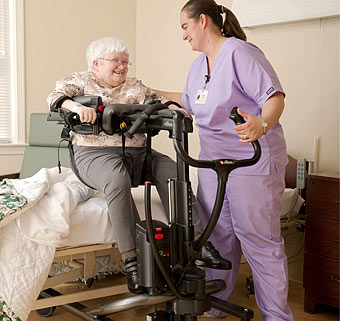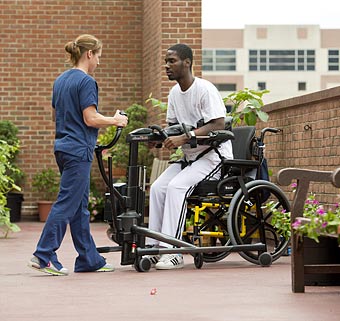
An Interview with Wendy Weaver, Executive Director of the Association of Safe Patient Handling Professionals
Rifton: When and how did the Safe Patient Handling and Mobility (SPHM) movement begin?
Wendy: In the 1990’s data regarding worker injuries in the healthcare sector published by the Department of Labor began receiving more recognition and the topic of caregiver injury was brought to the forefront. Administrators and clinicians were unhappy with regard to the numbers of colleagues/employees being injured and unable to work. Because of research being conducted, the issue became more defined and the “field” grew. With the Safe Patient Handling and Mobility (SPHM) movement, patient outcomes also improve –declined frequency of skin tears, bruising, pressure ulcers, pain, as well as the safe provision of earlier mobility in rehab efforts with the appropriate use of equipment.
Progressing into the 2000’s there has been more and more data concerning worker injury, patient outcomes, and the benefits of SPHM. Among the earlier thought leaders were Dr. Audrey Nelson, Dr. Bernice Owen, Dr. Tom Waters, Arun Garg and Guy Fragala. These and many others were the voices that brought attention to the fact that numerous workers were being injured by manually lifting and moving those for whom they were providing care, some having to terminate their careers in healthcare as a result.
What has been the role of the Veterans Administration?
The Tampa VA Research and Education Foundation was founded in 1997 with the mission to facilitate research related activities, education and training at the James A. Haley VA Hospital. Through the work of Audrey Nelson and others, this foundation established the first national conference on safe patient handling, held in Orlando about 12 years ago.
This conference became an annual event, contributing to the groundswell of awareness; it really pushed the movement along. It was exciting. People were attracted to the conference because they believed in the cause and were able to access more in depth education. They wanted to become informed and learn how to make the change to a culture of safety for their employees and colleagues. It also allowed them to become familiarized with equipment currently available. It is still growing and evolving: in 2015, this conference is now expanded to include both safe patient handling and mobility and patient falls prevention.
Today, there are other organizations besides the VA who are stepping up to provide the education and resources necessary to encourage and facilitate implementation of Safe Patient Handling and Mobility movement programs. One of these is the Association of Safe Patient Handling Professionals for which I am currently the Executive Director. ASPHP was founded in 2011, so it is a young organization, but certainly our members and our board are among the best human resources on safe patient handling in the industry.
Tell me about how ASPHP started.
The Association of Safe Patient Handling Professionals began when two individuals, Kent Wilson and Dave Davis, realized there was a need for a certification to acknowledge practitioners who were competent in Safe Patient Handling and Mobility. They approached me and others with the concept and after several organizing meetings/discussions, there was a consensus to move ahead with an organization. Our mission: To improve the safety of caregivers and their patients by advancing the science and practice of safe patient handling.
By October of 2010, we had eight individuals ready to found the organization. All were highly qualified and thoroughly committed to the mission. These were: Rick Barker, Senior Consultant and Ergonomics Engineer for Humantech; Colin Brigham, Vice President, Safety Management and Ergonomics with 1Source Safety and Health, Inc; Dave Davis, HoverTech International; Guy Fragala, Senior Advisor for Ergonomics at the Patient Safety Center of Inquiry in Tampa; Catherine Gouvin, Certified Hand Therapist, Certified Specialist in Health Ergonomics; Bob Williamson, Director of Associate Safety for Ascension Health; Kent Wilson, Safety Program Director, HoverTech International; and myself. 
We all realized that a safe patient handling certification program would help the SPHM profession by recognizing individuals that were experienced and knowledgeable in the field. We knew also that it would increase national awareness of SPHM, which is so crucial to quality healthcare, yet still underutilized.
In addition, we liked the concept of a membership organization that would give legitimacy to the certification: by bringing like-minded individuals together in an association, we could learn from each other and provide a voice for the SPHM movement.
We were incorporated as a non-profit 501(c )(3)organization and launched at the annual Safe Patient Handling Conference held in March 2011.
How are you achieving your mission today?
There is a growing interest in obtaining the certification we offer. The Association of Safe Patient Handing Professionals is now international, with members from England and Australia, and we are modifying our exams to be appropriate for international use.
Currently, our certification is based on nine core competencies:
Our website explains the certification, which we offer in two levels: an associate’s certification (CSPHA) and a professional certification (CSPHP). Only the professional certification involves completion of an exam. Ongoing contact hours are required for renewal of each which occurs every three years.
As a member in the organization, one benefits by access to discounts on educational events: monthly webinars and one day conferences held throughout the country, both of which award contact hours. The ASPHP is licensed by the California Board of Registered Nursing for issuing contact hours. Another benefit of membership is access to many experts in the field, including our Board of Directors. Members have submitted questions to the office and we can generate answers rather promptly for them. We continue to collaborate with other organizations to further our mission. For example, 13 of our board members and regular members contributed to the work group led by the ANA in writing the SPHM Interprofessional National Standards. We work cooperatively with the VA and now regularly sponsor the annual SPHM national conference.
Can you explain the expansion of the SPH acronym to now include M for mobility?
By adding “Mobility” to the name, we extend the purpose of SPHM to focus more on patient outcomes. Incorporating this dimension is key. In order to get the full attention of administrators it is important to demonstrate that patient outcomes are improved when SPHM is implemented. Practicing safe patient handling and mobility protects patients as well as caregivers/employees.
What do you view as some of the primary barriers to implementing a culture of safety and SPHM in healthcare environments across the US?
Firstly, finance. We need to engage and educate administrators. We need to foster the willingness of administrators to build Safe Patient Handling & Mobility into the budget and then maintain this budget. That’s why this is one of the core competencies that we teach: the ability to present to administrators the need for SPHM. When you look at the high cost of injury and the expense of workers’ compensation claims, the return on investment for a SPHM program is apparent and easily measured. Typically we see a full return on investment in only three to five years.
Secondly, people have to change their habits. A behavioral and culture change needs to happen.
Thirdly, teamwork. But here we see encouraging signs. Everywhere, people want to learn more about increasing cooperation between rehab, PTs, OTs, and nursing staff, particularly when it comes to early mobility and acute care. But teamwork is essential. Everyone needs to be involved and aware that it is “happening” in their facility.
So how will we see greater SPHM adoption and compliance? What does the future look like for ASPHP?
It comes down to educate, educate, educate; sharing the information that’s becoming available. And with our CSPHA and CSPHP certifications the field of SPHM will become better recognized and appreciated. We have wonderful testimonies from people who obtained our certification and returned to their companies to receive a promotion and with it, increased SPHM responsibility. This knowledge and expertise is in demand.
We will also see growth and improvement legislatively. Individual states are enacting legislation requiring safe patient handling and mobility programs and practices. And several of our board members were recently on Capitol Hill advocating for federal legislation. We have more information about this on our Learning Center where we post legislative updates.
And finally, we will continue to see improved designs from the SPHM equipment manufacturers. They are part of the team. The ASPHP collaboration with the vendors enables the spread of knowledge about the tools available. Vendors often apply for our associate’s certification and with this knowledge they are able to better assist their clients.